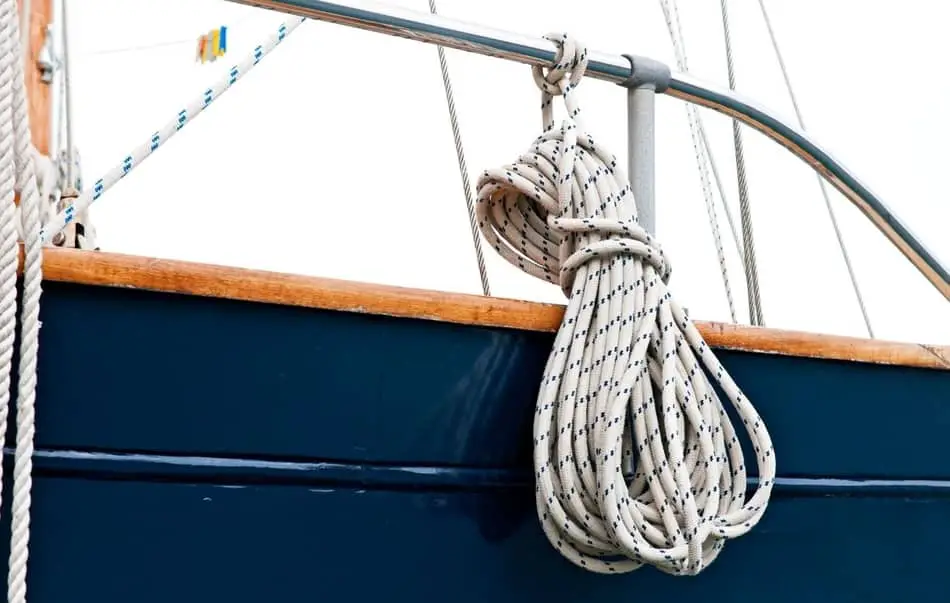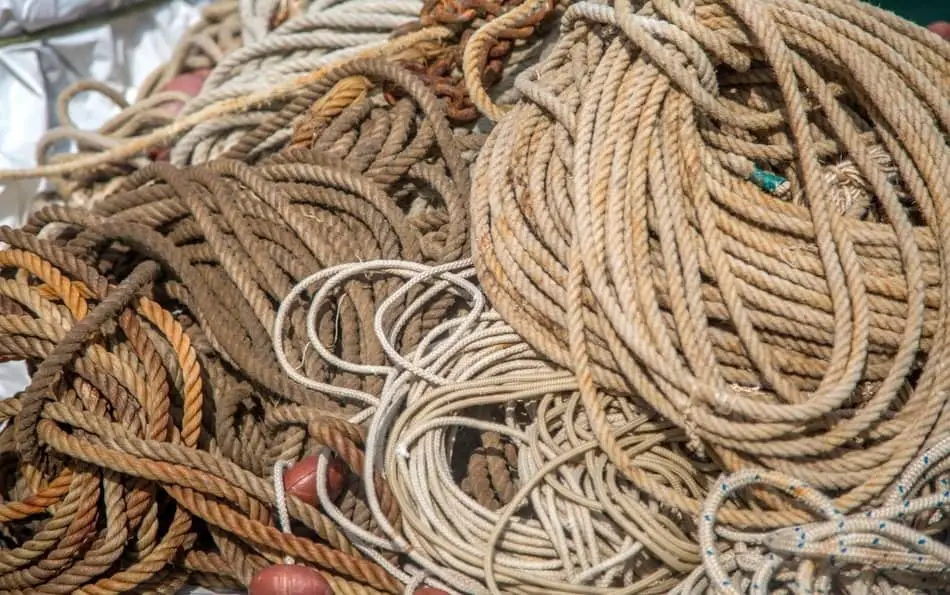Magically a rope turns into a line when you put it on a boat. And these lines are essential for boats because they hold the boat at the dock, and they hold the anchor, etc. So, the maintenance of those lines is essential. Here are a few tips for storing or stowing the boat lines safely.
Coiling the line (rope) and storing it on the boat railings or inside a bag or a bucket is one of the easiest and efficient ways to store the boat lines. But while storing them outside, you need to keep them away from the sunlight because sunlight can cause any damage to the lines.
Storing the boat lines depends on your accessibility (needs); if you often use them, you can keep it outside, on the railing or so. Or if you don’t use them regularly, you can store it inside the boat.
That gives us to store the boat lines in two ways. Outside to the railing or hangers Or inside the boat. Either way is okay, but you need to take some (extra) care if you store them outside.
And there are some common precautions you need to take before storing them as well (go below for the precautions) so that the lines will last long without any damages.
Without storing the boat lines properly, it will create a mess when you use them again. By arranging the lines properly on the boat, you can quickly use them and finish the job soon.
Okay, we will now see how to store the boat lines, and then we will see the precautions you need to take while storing them.

1. Store the lines (ropes) on the boat railings
Storing the lines on the railing is one of the common ways to store the lines, and if you often use them during the ride, then it would help you if you store it on the railings outside. Otherwise, store them inside.
Storing the lines on the railings can be done in two ways (basically). One is gasket coil (in the above picture), and another one is tying the whole rope to the railings instead of hanging it in the air with the bitter end (in the video below).
And finally, you can store it any way you want but don’t store them completely outside because storing them completely outside means the sunlight can damage the lines (on a hot sunny day).
If you often use them, only then store it on the railings otherwise store it inside or away from sunlight. And if you store them outside, use any cover to prevent sunlight from falling on the lines directly.
Check this small video to store the boat lines on the railings effectively without falling off from the railings.
2. Store the lines (ropes) inside the rope bag or bucket
You can store the lines inside a rope bag or a bucket. A rope bag or bucket keeps the lines off the ground and removes the need to coil it as it is stored stacked, which helps reduce twists.
And if you store it in a rope bag or bucket, you can keep them inside the boat (away from the sunlight) or outside the boat. By using UV protection bags, you can leave it outside without any worries.
And among a rope bag and a bucket. A rope bag would be a perfect choice because after removing the ropes from the bag for any usage, you can fold the bag, then you can store it easily, and it takes less space as well (without lines).
Whereas a bucket will eat up a big space in the boat, and you can’t fold the bucket as a bag after removing the lines from it. So, a rope bag will be a good choice to use instead of a bucket due to more storage space.
If you have a big boat, then you need not worry about whether you need a bucket or a rope bag. If you have a small boat, then you need to consider the available space in mind.
If you are looking for a good rope bag for storing lines or chains, then check out this product, click here (linked to Amazon), or click on the image below (linked to Amazon).

This bag is UV resistance meaning you leave in the sunlight for a long time. And you can conveniently close the top of the bag with the two straps so that ropes will not fall off.
3. Use line holders to store the lines
A line holder is also a perfect choice to store the lines if you don’t have railings on the boat. You can open the line holder strap and put your coil in and then close the strap.
If you use these line holders, then you can keep (fix) the holder wherever you want in the boat. This storing technique is the same as storing the line to the railing because in both the conditions, they are hanging.
Here we are tying the ropes to the holder instead of tying them to the railing as in the case of storing it on the railings. So, if you keep the holders outside, then try not to keep them under direct sunlight.
And if you often use them, store it outside; otherwise, store them inside or away from the sunlight.
If you are looking for good line holders, then check out this product, click here (linked to Amazon), or click on the image below (linked to Amazon). Having a line holder will help you a lot to store lines in a good way without any damage.

Those three are the most common ways to store the boat lines in the boat. And you store them however you want but storing them nicely will decrease damage to the lines. We will now see the precautions you need to take before storing them.
Precautions you need to take while storing the lines (ropes)

There are some precautions you need to take before keeping the lines inside the boat to improve the lines life. In the above picture, you can see that the lines are wearing off.
However, you can’t avoid wearing off entirely over time, but by doing some proper maintenance for the lines, you can improve the life of the boat lines to some extent. Here are precautions you need to take before storing lines (ropes).
- Don’t store the lines (ropes) on the ground.
- Clean the lines (ropes) after every use.
- Don’t store the lines (ropes) when they are wet.
- Don’t store the lines (ropes) near the heat or in direct sunlight.
- Keep the lines (ropes) far away from the chemicals (if any).
Two common problems to avoid: Before coiling up the line, remove all the knots, and then coil it. While storing it, avoid keeping it under any heavyweight objects to prevent any damages.
1. Don’t store the lines (ropes) on the ground
Leaving the lines on the ground will cause wearing off the lines over time. If you clean the boat regularly or have a clean floor inside the boat, then it is okay to leave the lines on the ground.
Otherwise, when the line is in contact with the ground, dirt gets into the rope and accelerates the wearing process. So use a rope bag or a bucket to keep the lines away from the ground.
At least keep something on the floor instead of keeping them directly on the floor if you don’t have a rope bag or bucket. You can use line holders as well.
2. Clean the lines (ropes) after every use
Cleaning the lines after every use is an essential work to do because if there is any dirt or anything got stuck inside the twists of the lines, then it can damage the lines quickly.
Not only the dirt, even if you use the lines in saltwater, and if you didn’t wash them with fresh water, lines would wear off quickly because salt particle will be stuck on the rope and can damage it quickly.
An anchor line should be cleaned well with the freshwater after taking it out of the water and then only store the rope.
3. Don’t store the lines (ropes) when they are wet
If the lines are wet and you store them, it can wear off quickly because the water will damage each tiny threads in the rope, which results in wearing off the line quicker than ever.
So, drying the lines before storing is an essential work to do and don’t dry them in the sunlight because direct sunlight on the lines can damage the lines as well. You can dry it under the shade (air is enough to dry them).
Loosely chaining the line will result in efficient drying. So, and after chaining the line, let it dry for some time (source).
4. Don’t store the lines (ropes) near the heat or in direct sunlight
Don’t keep the lines directly under the sunlight or near any hot surface (if any) because if you keep the lines near to the heated surfaces, it can fade out quickly and eventually wears off quickly.
And exposing the lines to the sunlight for a long time will eventually wear off the tiny threads in the line, and then the whole line will be damaged. So, don’t leave it under direct sunlight.
5. Keep the lines (ropes) far away from the chemicals (if any)
If there are any chemicals (especially any hull cleaner or so) on the boat, then don’t keep the lines near it. Hull cleaner will contain some percentile of acids in it, and if they fell on the rope, it will instantly damage the rope.
So, if you have any boat or hull cleaner in the boat, then don’t keep the lines near them. And avoid keeping the lines on the wetted surfaces as well to prevent any damages.
Key takeaways
Coiling the lines is the easiest way to store the lines, and you can take it out easily. Wherever you want, you can keep them (inside or outside), it depends on your needs and accessibility.
If you use them regularly (often) during boating, then it will help if you store them outside to railings or anything rather than inside. So, you can take them and use them efficiently and finish the job quickly.
So, if you don’t use the lines often, then store it inside the boat. Coiling the lines is one work, and storing them properly is another work. If you coil it well and if you didn’t store them properly, you increase the chances of failure.
- Don’t store the lines (ropes) on the ground.
- Clean the lines (ropes) after every use.
- Don’t store the lines (ropes) when they are wet.
- Don’t store the lines (ropes) near the heat or in direct sunlight.
- Keep the lines (ropes) far away from the chemicals (if any).
Properly storing the lines will decrease the line failures.
